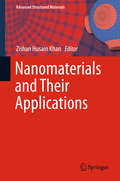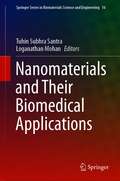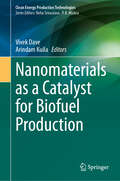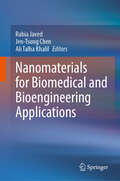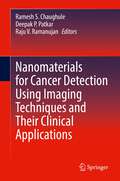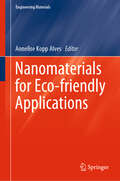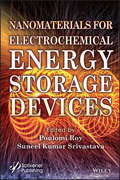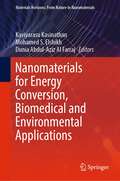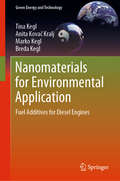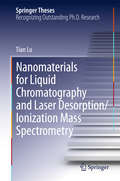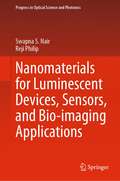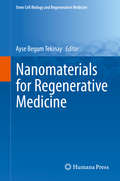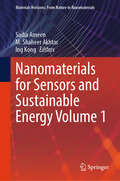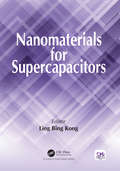- Table View
- List View
Nanomaterials and Their Applications (Advanced Structured Materials #84)
by Zishan Husain KhanThis book focuses on the latest advances in the field of nanomaterials and their applications, and provides a comprehensive overview of the state-of-the-art of research in this rapidly developing field. The book comprises chapters exploring various aspects of nanomaterials. Given the depth and breadth of coverage, the book offers a valuable guide for researchers and students working in the area of nanomaterials.
Nanomaterials and Their Biomedical Applications (Springer Series in Biomaterials Science and Engineering #16)
by Tuhin Subhra Santra Loganathan MohanThis book highlights the evolution of, and novel challenges currently facing, nanomaterials science, nanoengineering, and nanotechnology, and their applications and development in the biological and biomedical fields. It details different nanoscale and nanostructured materials syntheses, processing, characterization, and applications, and considers improvements that can be made in nanostructured materials with their different biomedical applications. The book also briefly covers the state of the art of different nanomaterials design, synthesis, fabrication and their potential biomedical applications. It will be particularly useful for reading and research purposes, especially for science and engineering students, academics, and industrial researchers.
Nanomaterials as a Catalyst for Biofuel Production (Clean Energy Production Technologies)
by Arindam Kuila Vivek DaveThis contributed volume addresses several environmental problems using nanoparticles/nanomaterials for renewable energy and biofuel production. It presents nanomaterials as catalysts that can enable better selectivity, yield, and quality in renewable energy and biofuel production. The rapid expansion of industries and human population has resulted in a significant increase in the generation of waste and environmental pollution, posing a significant threat to the environment and human health. People are looking for safer and more eco-friendly fuels to meet energy demand and preserve the world for future generations. Renewable energy and biofuels are alternative techniques that reduce fossil fuel consumption. The advancement in the field of nanotechnology has led to the development of nanocomposites/nanomaterials, which are composed of nanoscale particles and polymers. Their application in the environment has shown great potential in addressing environmental issues such as pollution control and waste management. Nanocomposites are advanced materials with unique properties, such as improved mechanical strength, thermal stability, and flame resistance, making them attractive for a wide range of applications, including environmental applications. Nanomaterials show great potential for sustainable biofuel production with commercial feasibility. Nanotechnology-based various conversion routes effectively convert waste biomass into value-added biofuels, such as syngas, biodiesel, and HVO. This book discusses the green synthesis of nanocomposites/nanomaterials for biofuel production and renewable energy. Additionally, it covers techno-economic analysis of bioremediation using green-synthesized nanoparticles/nanomaterials. This book will be helpful for researchers, engineers, and scientists working in the areas of environmental biotechnology, materials science, nanotechnology, environmental science, and engineering.
Nanomaterials for Advanced Technologies
by Jitendra Kumar Katiyar Vinay Panwar Neha AhlawatThis book presents experimental as well as simulation methodologies for analysis and development of nanostructures for introducing the desirable effects through modifications in the basic structure of select nanomaterials. The initial chapters in this book focus on exploring the basic aspects of nanomaterials, e.g., distinguishing features, synthesis, processing, characterization, simulation and application dimensions, or nanostructures that enable novel/enhanced properties or functions. The chapters also cover the size-dependent electronic, optical, and magnetic properties of nanomaterials in exposing the specific properties essential for applications in nanophotonics, nanoplasmonics, nanosystems (e.g., biological, medical, chemical, catalytic, energy, and environmental applications), and nanodevices (e.g., electronic, photonic, magnetic, imaging, diagnostic, and sensor applications). This book is a useful resource for students, researchers, and technologists in gathering recent knowledge on novel nanostructures and their use in different application areas.
Nanomaterials for Biomedical and Bioengineering Applications
by Jen-Tsung Chen Rabia Javed Ali Talha KhalilThis book accumulates the most recent advancements in the field of bioengineering regarding hybrid science named nanobiotechnology and enriches the readers with vast and comprehensive knowledge about different biomedical applications of nanomaterials. It includes drug and gene delivery, tissue engineering, antimicrobial properties, hyperthermia, cancer therapy, bioimaging, biosensing, photoablation therapy, etc., utilizing the potential of different nanomaterials that are helpful for the well-being of diseased individuals. Furthermore, the concerns about multidrug-resistant microorganisms are increasing daily in the healthcare system. Since conventional therapies fail to combat various infectious diseases, novel nanotechnology techniques provide an alternative approach to developing innovative biomaterials. The novel features of nanomaterials need to be exploited for use in the biomedical engineering domain. They should be fabricated so that the novel multifunctional nanomaterials notonly improve drug efficacy but also reduce their side effects. Moreover, a detailed understanding of the nanotoxicological effects of promising biomedical nanomaterials should necessarily be explored using the cell culture approach. Corona of nanomaterials should be investigated in detail to determine its fate in the biological system regarding safety concerns. This is the most important feature that is novel and explored in this book and would be very helpful for customers like clinicians, scientists, engineers, and technicians who will gain extensive knowledge from this book and work together to get the desired results in the healthcare sector.
Nanomaterials for Cancer Detection Using Imaging Techniques and Their Clinical Applications
by Ramesh S. Chaughule Deepak P. Patkar Raju V. RamanujanThis book presents nanomaterials for cancer detection using a variety of state-of-the-art imaging techniques. Clinical applications are also highlighted. The unique size-dependent properties and convenient surfaces for molecular assembly make these nanomaterials essential for a variety of innovative imaging techniques. This book covers important imaging modalities, synthesis of nanoparticles with specific functional properties, and clinical applications including the development of anticancer drugs. The information presented here involves contributions from chemistry, materials science, materials characterization, cell engineering, and clinical testing.The book will be essential reading to experienced clinicians as well as a wide range of scholars and researchers interested in nanotechnology and imaging techniques for cancer detection.
Nanomaterials for Eco-friendly Applications (Engineering Materials)
by Annelise Kopp AlvesThis book presents a wide range of synthesis and characterization techniques to produce ceramic nanomaterials specially developed to be used in environmental applications. The book cover synthesis using hydrothermal, chemical vapor deposition, sol-gel, emulsification, magneto-sputtering, among other process and modern characterization techniques with detail. The use of the synthesized materials in eco-friendly approaches such as photocatalysis, solar energy efficiency improvement, absorbents, sensors, solar cells, biofuels and waste reuse are reported in detail.
Nanomaterials for Electrochemical Energy Storage Devices
by Suneel Kumar Srivastava Poulomi RoyEnergy storage devices are considered to be an important field of interest for researchers worldwide. Batteries and supercapacitors are therefore extensively studied and progressively evolving. The book not only emphasizes the fundamental theories, electrochemical mechanism and its computational view point, but also discusses recent developments in electrode designing based on nanomaterials, separators, fabrication of advanced devices and their performances.
Nanomaterials for Energy Applications (Emerging Materials and Technologies)
by Shaik Feroz L. Syam Sundar Faramarz DjavanroodiNanomaterials for Energy Applications provides readers with an in-depth understanding of advanced nanomaterials and their applications in energy generation and utilization concepts. It focuses on emerging nanomaterials and applications in various energy-related fields. Describes nanomaterials for use in photovoltaic cells, solid state lighting, fuel cells, electrochemical batteries, electrochemical capacitors, superconductors, hydrogen storage, and photocatalysts. Focuses on commercial and economic aspects. Includes case studies drawn from practical research. This book is aimed at researchers, advanced students, and practicing engineers in the disciplines of materials, mechanical, electrical, and related fields of engineering.
Nanomaterials for Energy Conversion, Biomedical and Environmental Applications (Materials Horizons: From Nature to Nanomaterials)
by Kaviyarasu Kasinathan Mohamed S. Elshikh Dunia Abdul-Aziz Al FarrajThis book highlights a multidisciplinary system for the future while protecting our environment. Certainly, the main objective of the proposed book has addressed several issues and bringing a good platform to understanding for future developments in metal oxide nanostructures for energy conversion, biomedical, and environmental management, however, which is support/carrier for antibacterial behaviors, pathogen infections, and bioinspired materials for energy savings and environmental impacts. Appropriately, I recommend the book to undergraduates, postgraduates, and doctoral students those who are working in materials science and researchers across the world working in interdisciplinary research.
Nanomaterials for Energy and Sensor Applications
by Vidya Nand Singh Sunil Singh KushvahaNowadays, most of the research focuses on nanomaterials in which one of the dimensions falls in the 1-100 nm range. These nanomaterials can be thin films, quantum dots, nanowires, nanopyramids, and nanoclusters. Thus, nanomaterials are impacting almost all aspects of materials for various applications in emerging energy and sensor devices. The book comprises ten chapters and discusses nanomaterial applications in energy, solar cells, water splitting, sensors, etc. The book caters to budding researchers’ needs in synthesizing nanomaterials and post-graduate students.
Nanomaterials for Environmental Application: Fuel Additives for Diesel Engines (Green Energy and Technology)
by Breda Kegl Marko Kegl Tina Kegl Anita Kovač KraljThis book explores the use of nanomaterials as diesel fuel additives. It extensively reviews the diesel engine characteristics and the most frequently used nanomaterials and nanofuels and discusses the practical issues regarding the viability of nanomaterials as fuel additives from technical, environmental, and human health viewpoints. Special attention is focused on questions related to the short-term use of nanomaterials in diesel engines, such as: · What are the most important nanomaterial activities in diesel engines? · What happens to nanomaterials at various stages, from the fuel tank to exhaust? · What are the effects of nanofuel usage on diesel engine characteristics? and · What are the effects of nanomaterials on diesel engine parts and systems? Given its scope, this book is a valuable resource for researchers and engineers in environmental science, mechanical engineering, and chemical engineering fields, as well as for advanced undergraduate and postgraduate students.
Nanomaterials for Environmental Applications (Emerging Materials and Technologies)
by Mohamed Abou El-Fetouh BarakatNanomaterials for Environmental Applications offers a comprehensive review of the latest advances in nanomaterials-based technologies for the treatment of emerging contaminants in wastewater. It describes the latest developments in the synthesis protocols, including the synthesis of different kinds of nanostructure materials using various physical and chemical methods. Features Discusses the synthesis and characterization of important nanomaterials such as carbon nanostructures, metal and metal oxide nanostructures, polymer nanostructures, and smart 1D-–3D nanomaterials Presents the latest techniques used in the characterization of nanomaterials Covers environmental applications including the remediation of pollutants in wastewater and water purification and disinfection Examines the sources, fate, transport, and ecotoxicology of nanomaterials in the environment. Aimed at researchers and industry professionals, this work will be of interest to chemical, environmental, and materials engineers concerned with the application of advanced materials for environmental and water remediation. Mohamed Abou El-Fetouh Barakat is a Professor of Environmental Sciences at both King Abdulaziz University (KAU)- Saudi Arabia, and Central Metallurgical R&D Institute (CMRDI)- Egypt. He is highly qualified in the fields of industrial waste management and pollution control as well as catalysis and nanotechnology. His experience includes academic research works in Japan, Germany, the United States and Saudi Arabia, as well as initiating and leading industrial research projects in Egypt jointly with the United States. Rajeev Kumar is an Associate Professor in the Environmental Science Department, King Abdulaziz University, Jeddah, Saudi Arabia. His research activities are in the areas of wastewater treatment and materials science. He studies the adsorption and photocatalytic properties of nanomaterials for the removal of contaminants from wastewater.
Nanomaterials for Environmental Protection
by Boris I. Kharisov H. V. Dias Oxana V. KharissovaThis book is divided into four main sections thoroughly analyzing the use of nanomaterials for water, air and soil solutions, and emphasizing environmental risks. Providing background on nanomaterials' two-decade study, it discusses the characterization and application of unconventional disinfectants, called antimicrobial nanomaterials, which fall into three categories and, while seemingly harmless, have potential hazards if applied improperly. Special attention is given to the process of remediation, synthetics techniques, and properties of nanomaterials, with examples to which new and trained readers in the field can relate and understand.an interdisciplinary approach, aimed at scientists in physical chemistry, nanotechnology, and environmental sciencesincludes applications of non-conventional techniques in environmental protectionfurthers the development of applied nanoscience and nanotechnologysuggests new industrial projects and university courses addressing nanotechnology in and for the environmentincludes applications for water, air and soil protection
Nanomaterials for Environmental and Agricultural Sectors (Smart Nanomaterials Technology)
by Azamal Husen Rakesh Kumar Bachheti Archana BachhetiThis book gives a complete overview of current developments in nanotechnology-based environmental remediation and sustainable agriculture practices/sectors. It will provide the use of nanotechnology in the agricultural sector such as crop production and improvement, soil fertility management along with benefits and risks of nanotechnology on ecological farming. Additionally, the book also discovers how nanotechnology is used in water, air remediation techniques and major challenges in using nanomaterials for improving water and air quality. The book can be a reference source for academicians, scientists, policymakers, students, and research scientists working in minimizing the environmental pollution and increasing agricultural production using nanoparticles.
Nanomaterials for Healthcare, Energy and Environment (Advanced Structured Materials #118)
by Mohammad Jawaid Imran Khan Aamir Hussain Bhat Fakhreldin O. Suliman Haider Al-Lawati Salma Muhamed Al-KindyThis book highlights the various types of nanomaterials currently available and their applications in three major sectors: energy, health, and the environment. It addresses a range of aspects based on the fact that these materials’ structure can be tailored at extremely small scales to achieve specific properties, thus greatly expanding the materials science toolkit. Further, the book pursues a holistic approach to nanomaterial applications by taking into consideration the various stakeholders who use them. It explores several applications that could potentially be used to improve the environment and to more efficiently and cost-effectively produce energy, e.g. by reducing pollutant production during the manufacture of materials, producing solar cells that generate electricity at a competitive cost, cleaning up organic chemicals that pollute groundwater, removing volatile organic compounds (VOCs) from the air, and so on. Given its scope, the book offers a valuable asset for a broad readership, including professionals, students, and researchers from materials science/engineering, polymer science, composite technology, nanotechnology, and biotechnology whose work involves nanomaterials and nanocomposites.
Nanomaterials for Liquid Chromatography and Laser Desorption/Ionization Mass Spectrometry
by Tian LuTian Lu's dissertation describes major advances in ultrathin-layer chromatography (UTLC), liquid chromatography and surface-assisted laser desorption ionization (SALDI), and matrix-enhanced SALDI (ME-SALDI) mass spectrometry. Lu describes the fabrication of electrospun polyvinyl alcohol (PVA) UTLC plates using an in-situ crosslinking electrospinning technique. The author improved the efficiency of PVA plates greatly compared to the efficiency of silica HPTLC plates. Also highlighted in this thesis is an edge-plane based ordered-carbon surface that provides unique selectivity in liquid chromatography. Further developments include polar analytes, such as amino acids, nucleotides and nucleosides which can be well-retained and separated in the edge-plane ordered-carbon stationary phase. Also, the author studied and detected mass spectra of organic polymers as high as 900,000 Da, the highest molecular weight that has been studied by SALDI to date using the carbon nanofibrous substrate. This thesis has led to a number of publications in high-impact journals.
Nanomaterials for Luminescent Devices, Sensors, and Bio-imaging Applications (Progress in Optical Science and Photonics #16)
by Swapna S. Nair Reji PhilipThis book highlights the synthesis/fabrication of novel materials for different kinds of optical applications. It covers all aspects of optical applications starting from LED/Lasers, SERS, bio-sensing, bio-imaging and non-linear optical applications such as optical limiting, saturable absorbers etc. The book describes the development of novel materials and geometry as well as engineering of their size and shape for harvesting better optical properties. Nonconventional plasmonic materials and their fabrication are discussed apart from the conventionally employed noble metal based nanosystems. In addition, development of Novel materials/structures for biosensing /bioimaging /optical limiting are also covered.
Nanomaterials for Regenerative Medicine (Stem Cell Biology and Regenerative Medicine)
by Ayse Begum TekinayThis book covers a broad range of therapeutic applications of nanomaterials that are used for regenerative medicine applications, including neural regeneration, cartilage regeneration, wound healing, dental regeneration and implants, and immunomodulation. Chapters are contributed by leading experts in the field and cover concepts for developing materials for medicine as well as requirements for potential clinical uses. Nanomaterials for Regenerative Medicine also provides the requirements for the design of optimal nanomaterials for regenerative medicine and covers the most recent approaches in nanomaterial design. It is ideal for graduate students and researchers in chemistry, biology, materials science, medicine, and life sciences.
Nanomaterials for Sensors and Sustainable Energy Volume 1 (Materials Horizons: From Nature to Nanomaterials)
by Sadia Ameen M. Shaheer Akhtar Ing KongThis book offers readers an extensive insight into advanced nanomaterials and their applications in the realm of energy generation and utilization. It places a specific emphasis on emerging nanomaterials and their diverse applications within energy-related sectors and sensor technology. The primary focus is on comprehending how these materials enhance the performance of energy storage devices and sensors. Furthermore, the book provides a comprehensive overview of the significant challenges faced in these areas and presents a forward looking perspective. Comprising ten chapters, the book extensively explores the applications of nanomaterials in energy-related fields, specifically in solar cells, supercapacitors, sensors, and more. It caters to the needs of budding researchers involved in the synthesis of nanomaterials and post-graduate students interested in delving into the intricacies of nanomaterials.
Nanomaterials for Sensors and Sustainable Energy Volume 2 (Materials Horizons: From Nature to Nanomaterials)
by Sadia Ameen Ing Kong Shaheer M. AkhtarThis book offers readers an extensive insight into advanced nanomaterials and their applications in the realm of energy generation and utilization. It places a specific emphasis on emerging nanomaterials and their diverse applications within energy-related sectors and sensor technology. The primary focus is on comprehending how these materials enhance the performance of energy storage devices and sensors. Furthermore, the book provides a comprehensive overview of the significant challenges faced in these areas and presents a forward looking perspective. Comprising ten chapters, the book extensively explores the applications of nanomaterials in energy-related fields, specifically in solar cells, supercapacitors, sensors, and more. It caters to the needs of budding researchers involved in the synthesis of nanomaterials and post-graduate students interested in delving into the intricacies of nanomaterials.
Nanomaterials for Solid State Hydrogen Storage
by Zbigniew S. Wronski Tomasz Czujko Robert A. VarinOver the past decade, important advances have been made in the development of nanostructured materials for solid state hydrogen storage used to supply hydrogen to fuel cells in a clean, inexpensive, safe and efficient manner. Nanomaterials for Solid State Hydrogen Storage focuses on hydrogen storage materials having high volumetric and gravimetric hydrogen capacities, and thus having the highest potential of being applied in the automotive sector. Written by leading experts in the field, Nanomaterials for Solid State Hydrogen Storage provides a thorough history of hydrides and nanomaterials, followed by a discussion of existing fabrication methods. The authors' own research results in the behavior of various hydrogen storage materials are also presented. Covering fundamentals, extensive research results and recent advances in nanomaterials for solid state hydrogen storage, this book serves as a comprehensive reference.
Nanomaterials for Supercapacitors
by Ling Bing KongNew materials hold the key to fundamental advances in energy conversion and storage, both of which are vital in order to meet the challenge of global warming and the finite nature of fossil fuels. Nanomaterials in particular offer unique properties or combinations of properties as electrodes and electrolytes in a range of energy devices. Supercapacitors have been widely acknowledged to be promising devices for energy storage. This book describes the latest progress in the discovery and development of nanoelectrolytes and nanoelectrodes for supercapacitor applications.
Nanomaterials for Sustainable Development: Opportunities and Future Perspectives
by Rajaram S. Mane Rashmi P. Sharma Amruta P. KanakdandeThis book highlights recent advances in variety of nanomaterials classes including metal chalcogenides, metal oxides/hydroxides, polymer, metal-organic frameworks, and hybrid nanostructures, with a focus on their properties, synthesis methods, and key applications. It also offers detailed coverage on the toxicity aspects with possible solution. Additionally, it provides complete and comprehensive information on surface modification strategies of nanoparticles to achieve desired outcomes. This book discusses potential applications and major challenges of using these nanomaterials in the fields of biomedical sciences, agricultural industry, bioenergy, biofuel production, and environmental remediation, etc. Overall, this book provides crucial background in nanobiotechnology that compliments the understanding of experimental design for the production of more customized nanomaterials to avail desirable benefits.
Nanomaterials for Sustainable Hydrogen Production and Storage (Emerging Materials and Technologies)
by Alaa El Din Mahmoud Jude A. Okolie Alivia Mukherjee Emmanuel I. EpelleHydrogen is poised to play a major role in the transition towards a net-zero economy. However, the worldwide implementation of hydrogen energy is restricted by several challenges, including those related to practical, easy, safe, and cost-effective storage and production methodologies. Nanomaterials present a promising solution, playing an integral role in overcoming the limitations of hydrogen production and storage. This book explores these innovations, covering a wide spectrum of applications of nanomaterials for sustainable hydrogen production and storage. Provides an overview of the hydrogen economy and its role in the transition to a net-zero economy. Details various nanomaterials for hydrogen production and storage as well as modeling and optimization of nanomaterials production. Features real-life case studies on innovations in nanomaterials applications for hydrogen storage. Discusses both the current status and future prospects. Aimed at researchers and professionals in chemical, materials, energy, environmental and related engineering disciplines, this work provides readers with an overview of the latest techniques and materials for the development and advancement of hydrogen energy technologies.
